Why an Overclockable Core i3 Might Not Exist: The Supermicro C7H170-M and Intel Core i3-6100TE Review
by Ian Cutress on March 17, 2016 10:30 AM EST- Posted in
- CPUs
- Intel
- Motherboards
- Core i3
- Supermicro
- Overclocking
CPU Performance, Short Form
For our motherboard reviews, we use our short form testing method. These tests usually focus on if a motherboard is using MultiCore Turbo (the feature used to have maximum turbo on at all times, giving a frequency advantage), or if there are slight gains to be had from tweaking the firmware. We leave the BIOS settings at default and memory at JEDEC (DDR4-2133 C15) for these tests, making it very easy to see which motherboards have MCT enabled by default.
Video Conversion – Handbrake v0.9.9: link
Handbrake is a media conversion tool that was initially designed to help DVD ISOs and Video CDs into more common video formats. For HandBrake, we take two videos (a 2h20 640x266 DVD rip and a 10min double UHD 3840x4320 animation short) and convert them to x264 format in an MP4 container. Results are given in terms of the frames per second processed, and HandBrake uses as many threads as possible.
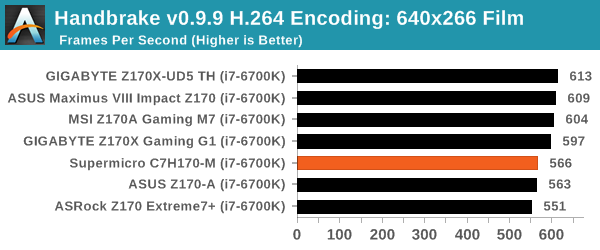
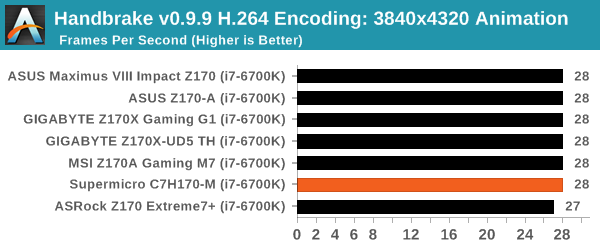
Compression – WinRAR 5.0.1: link
Our WinRAR test from 2013 is updated to the latest version of WinRAR at the start of 2014. We compress a set of 2867 files across 320 folders totaling 1.52 GB in size – 95% of these files are small typical website files, and the rest (90% of the size) are small 30 second 720p videos.

Point Calculations – 3D Movement Algorithm Test: link
3DPM is a self-penned benchmark, taking basic 3D movement algorithms used in Brownian Motion simulations and testing them for speed. High floating point performance, MHz and IPC wins in the single thread version, whereas the multithread version has to handle the threads and loves more cores. For a brief explanation of the platform agnostic coding behind this benchmark, see my forum post here.
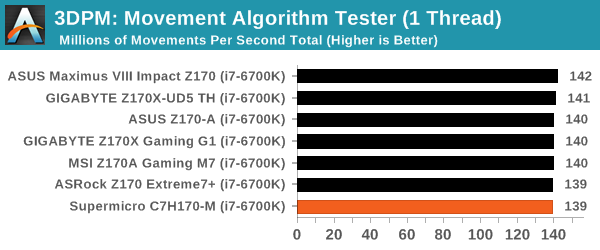
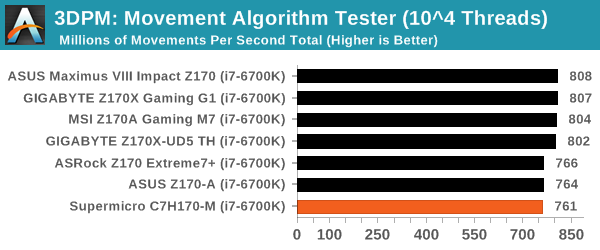
Rendering – POV-Ray 3.7: link
The Persistence of Vision Ray Tracer, or POV-Ray, is a freeware package for as the name suggests, ray tracing. It is a pure renderer, rather than modeling software, but the latest beta version contains a handy benchmark for stressing all processing threads on a platform. We have been using this test in motherboard reviews to test memory stability at various CPU speeds to good effect – if it passes the test, the IMC in the CPU is stable for a given CPU speed. As a CPU test, it runs for approximately 2-3 minutes on high end platforms.
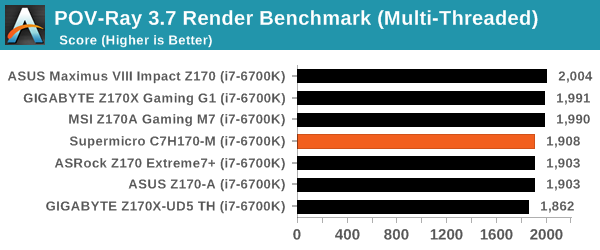
Synthetic – 7-Zip 9.2: link
As an open source compression tool, 7-Zip is a popular tool for making sets of files easier to handle and transfer. The software offers up its own benchmark, to which we report the result.











62 Comments
View All Comments
Taristin - Thursday, March 17, 2016 - link
Total War: Atilla shows the incorrect graph for performance with a GTX card. It shows the Alien Isolation score (Which is... significantly different!)yannigr2 - Thursday, March 17, 2016 - link
Did I saw an Athlon 845 somewhere in there? Is a review incoming?Bad Bimr - Thursday, March 17, 2016 - link
I miss the days of the cheap CPU with BIG TIME OC potential. My first foray in OCing was with the legendary Celeron 300A. That got me hooked. Next was the P3 600 and next came the P4 2.8 (Northwood) followed by the i7-920. Last year I bought a i7-4790k only to sell it when I came upon a thread on X-58 Xeon overclocking. Currently rocking a very conservative Xeon x5675 @ 4.15 Ghz (25x166) on stock voltage on air on all 6 cores with HT on. I have had it stable to 4.4 GHz but feel better with the lower voltage, plenty fast enough. Total cost for the x5675, $76 on eBay! I love cheap CPU overclocking.OrphanageExplosion - Friday, March 18, 2016 - link
This is a remarkable article. Anandtech has overclocked a *really slow* Core i3 processor so that it's not as fast as the slowest consumer-level i3 and written a *15-page* piece on it?!Why didn't you just buy the Core i3 6100?
The data elsewhere demonstrates why Intel never released a K i3 - it gives quad-like performance for gaming at 4.4GHz, where the i5 is king. The value argument is diluted a bit by the fact you will need a third party cooler though, while the i5 6500 is pretty awesome just with a stock HSF and some fast DDR4.
I really, really hope that AMD targets this sector aggressively with Zen - it could be a game-changer.
ReverendDC - Friday, March 18, 2016 - link
The perfect explanation why AMD is needed in the CPU space as well. No competition = restrictions to force more purchases from a single vendor.Achaios - Friday, March 18, 2016 - link
I was thinking, looking at the gaming benchmarks, that I am going to be stuck with the 4770k for maaaaaaannnnyyyy years to come.JoeyJoJo123 - Friday, March 18, 2016 - link
I honestly think asking why an i3 K-series processor doesn't exist is an awful question.I think the real question here that everyone isn't asking is:
"Why is Intel even selling non-K processors in anything but business grade (Xeon) CPUs?"
Doing a 15 page investigation where you compare an awful starting point locked i3 sample (one that isn't even relevant to consumers), examining its overclocked results, and the results of a locked i5 sample, then concluding that yes, the lower grade processor indeed does have worse performance than an i5, that might be why they don't have a K-series i3, is both completely obvious yet misses the point entirely.
Overclocking is a choice for the consumer. Whether or not the i3 part fully closes the gap with an i5 part is irrelevant, and if it doesn't close the gap, that's not a valid reason to then conclude that's why they don't sell K-series i3's. Overclocking gets me more performance than stock, and regardless of how big or small the overclock is, it should be up to the user to choose whether to overclock, not up to the manufacturer to dictate whether you can attempt to overclock at all (with non-K chips.)
I still can't understand why people are trying to find logic in strategic marketing placement of Intel chips (ie: rationalizing it for Intel, exactly what their marketing department wants) when you should be asking "Why are you selling me a locked down chip? I should be free to run this at whatever level of performance I can muster, as after I purchase this product, it is wholly mine to use as I please"
RobATiOyP - Sunday, March 20, 2016 - link
From the OEM & Intel's point of view, having ppl add volts & frequency to their complicated processors, may well lead to unstable chips or non-functioning, which may be (attempted) to be returned under warranty. If you buy a 3GHz locked CPU they're not fleecing you by not letting it be run faster, like options you pay more for.What is more annoying to me, is how there are various instruction options, like encryption & virtualisation which they turn on/off for market segmentation.
zodiacfml - Friday, March 18, 2016 - link
Awesome. More care and effort was given here than I expected.Simply, Intel refuses to. Limiting higher frequencies to i5 and i7. The market Intel is limiting is gaming market. They might open it if AMD, miraculously, becomes competitive again.
TheHolyLancer - Friday, March 18, 2016 - link
honestly i think the author missed the fact that intel( and amd to a point ) prices their stuff no-linearlyto jump from a pentium to i3 may only be 50 but to jump from i5 to i7k or the extreme (well soon? for the 2011 revamp?) costs a lot more
i remember the i7 920 too and with an oc i had i7 965 extreme levels of performance for way way cheaper